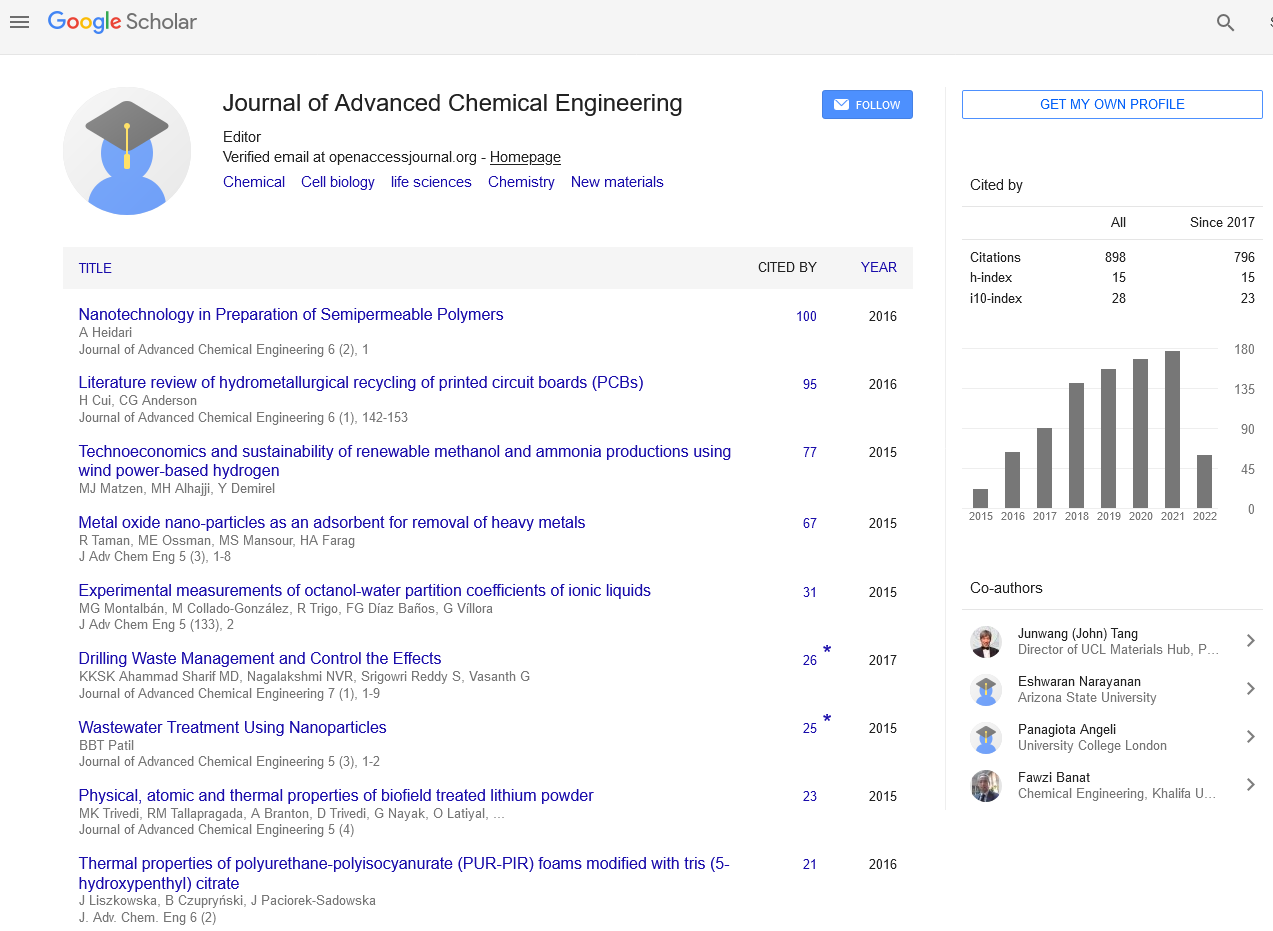Indexed In
- Open J Gate
- Genamics JournalSeek
- Smithers Rapra
- RefSeek
- Directory of Research Journal Indexing (DRJI)
- Hamdard University
- EBSCO A-Z
- OCLC- WorldCat
- Scholarsteer
- Publons
- Geneva Foundation for Medical Education and Research
- Google Scholar
Useful Links
Share This Page
Journal Flyer

Open Access Journals
- Agri and Aquaculture
- Biochemistry
- Bioinformatics & Systems Biology
- Business & Management
- Chemistry
- Clinical Sciences
- Engineering
- Food & Nutrition
- General Science
- Genetics & Molecular Biology
- Immunology & Microbiology
- Medical Sciences
- Neuroscience & Psychology
- Nursing & Health Care
- Pharmaceutical Sciences
Abstract
SURMOF induced crystallization and morphology engineering
Bolla G
SAMs are a well-known method and used to form reproduce various less stable polymorphs or crystalline morphologies (different faces), but the results are often not practical due to the limitation in contribution to the total surface. On account to that, recently SAMs are extended as SURMOFs, which are principally deposition of MOFs on SAM heterosurfaces. Apart from SAMs and SURMOFs there are few more additional directions were reported by different groups towards pharmaceutical drugs. SURMOFs have been studied recently with different applications. The advantage of controlled orientation of the MOFs on the basis of the ground SAM functional group would allow preferential growth of the target functional group of small organic molecules, but this young branch of chemistry not yet been explored in the direction of morphological engineering. MOFs being highly porous crystalline materials, their impact and contribution on the surface as a heterogeneous layer are quite effective when compared with the usual SAM surface. In addition, they can lead to different nucleation and growth directions than the usual crystallization path. The template SURMOF crystallization method involves three steps. (1) SAMs are prepared using gold substrates and thiol solutions; (2) MOF film preparation from solutions using layer by layer dipping (LBL-D); and (3) Crystallization of the organic solid. These SURMOF substrates were designed to investigate how the template functionalization of highly porous surfaces (SURMOFs) can influence the nucleation of functional organic molecules and morphological crystal engineering of benzamides (BZAs). The selection of BZAs was justified due to their lack of complex formation during crystallization with selected HKUST MOFs. Solution crystallization of BZA crystals resulted in plate morphology of (001), (011), (101) as major faces, whereas SURMOF crystallization suggested needle morphology with (001), (011) morphologically important faces and the major (101) face was retarded. Hence controlling one face with modified SURMOF surface crystallization is an alternative to the additive induced crystallization as the result matches to attain plate to needle crystals of BZA. As second example of 4-amino benzamide (ABZA) solution showed crystallization without substrate in EtOH as block morphology with (100) and (110) as major faces, with the primary amide chains N−H•••O, whereas ABZA crystals on the surface of the SURMOF substrate showed needles on the surface and block morphology at the edges, (111) as the major face and (001), (110), (100), (011), and (010), which confirmed nucleation of ABZA on MOF surface is different from normal solvent crystallization. Indeed, edge grown crystals showed needles of (100) face as the primary surface and also further showed (111) face of minor morphological importance. Hence, MOF pores can block the surface, which allows other faces to grow and further leads to different growth compared to normal experiments. The third example of 4-hydroxy benzamide (HBZA) was grown similar to BZA and ABZA. Well-grown single crystals showed rod morphology with (001), (011), and (010) and next crystals on the surface of the SURMOF heterogeneous substrate through solution phase epitaxy crystallization method were studied with multiple crystals at various places of the designed surface. These crystals showed plate morphology as (001) major and (011), (010), (100), and (101) of minor morphological importance. The MOF induced crystals grew along the c-axis through N−H•••O on the surface and block morphology at the edges whereas edge crystals were a balance of MOF and solution crystallization. To show the advantage of heterogeneous nucleation by SURMOFs an example of drug acetaminophen (N-acetyl-para-aminophenol, APAP) is presented. Formation of the less stable polymorph of APAP and the morphology changes using SURMOFs. APAP is a wellknown active pharmaceutical ingredient (an API, used as an analgesic and antipyretic drug; also referred to as paracetamol) and three polymorphs are reported wherein form I is less soluble and exhibits poor tableting compaction compared to form II, and another metastable form III. Forms I and II crystalize concomitantly in solution crystallization, form II was reported as needles whereas form I has blocks and prisms. From formulation and tableting point of view, form II is better due to its layered packing. However the reproducibility of form II during solution crystallization still remains a great challenge, but melt crystallization or the use of an additive can produce form II, but these methods are not suitable for industrial processing for bulk scale formulations. Hence studies continued to find suitable methods for the production of the form II. Crystal nucleation on the porous surface of SURMOF contributed significantly to unique nucleation kinetics, allowed for metastable phase stabilization and engineered the SURMOF with block morphology providing a dual advantage. This successful demonstration of MOF induced heterogeneous nucleation offers a new approach and opens challenges for metastable polymorph discovery along with inherent morphology differences based on complementary interactions at the SURMOF interface
Published Date: 2020-09-15;


